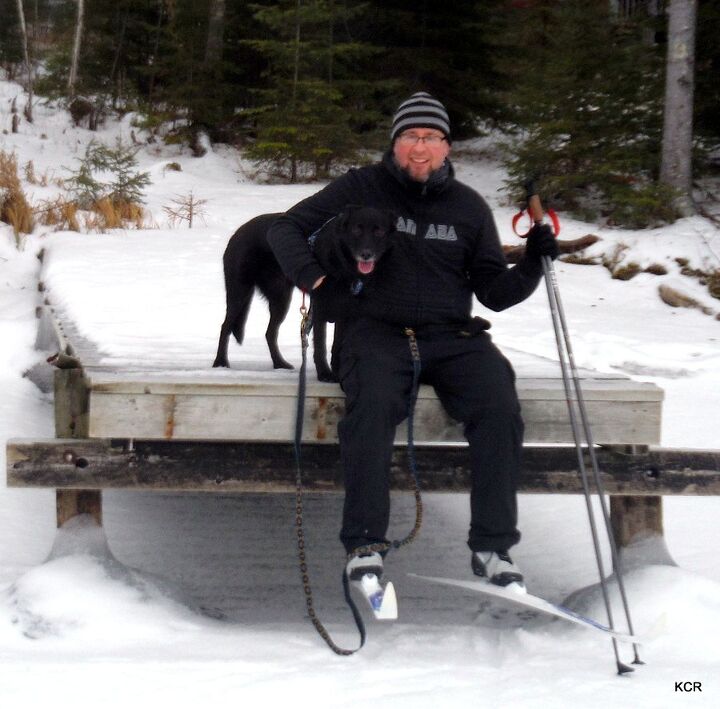How to Pick the Right Skis for Skijoring

Before we dig into the best gear available, we should start by explaining why skijoring is to anyone that may have come across this and is hearing about this underrated sport for the first time. Skijoring is often described as a cross between cross-country skiing and dog sledding. You strap on a pair of skis allowing you to glide along the trails like a typical cross-country skier, however, tethered in front of your is your dog, harnessed so that he can run and tow you along behind him.
Unlike dog sledding, there are no reins, whips, or other options to motivate your dog. Instead, the motivation to embrace the sport and participate comes from a combination of sheer excitement and solid communication between dog and owner. For this reason, it’s a great opportunity to work on strengthening the human-animal bond. This bond plays an important role both in any sports that you participate in together and even in basic training work.
While there are likely dogs of all shapes and sizes that have taken part in a modified version of skijoring of some form, the sport is traditionally for medium to large-sized dogs with the capability to use their strength and body weight to effective tow their handler.
The most important factor to consider is whether your dog enjoys the colder winter weather. If you have a dog that prefers to snuggle up indoors with the heat rolling, they likely aren’t going to have any fun engaging in this type of winter sport. However, if you have a dog that is well suited for the low temperatures and gets excited at the sight of snow, this is a great opportunity to harness their energy in a positive way.
When it comes to skijoring, there is a seemingly endless array of skis to choose from. Have no fear, I am here to narrow down the choices. But we warned, I am a total connoisseur of skis, and some would say snob.
At our house, we usually have at least five pairs for each skijorer. You don’t have to go that crazy, but I want to point out that even the experts sometimes have trouble narrowing it down to just one pair.
Related: Getting Started In Skijoring
If the plan is to skijor with your dog, limit your focus to cross country skis. Downhill skis just aren’t suitable. For one, they are often metal edged which could end in disaster when you crash, or hit your dog by accident. The other downfall of downhill skis is that the boot is designed for ripping power in awesome turns, not kicking and gliding.
Let’s glide on into your choices!
Even though the focus is on cross country skis there are plenty to choose from. We can break these down into classic ski, skate skis and backcountry or touring skis.
The type of ski you will pick largely depends on where you plan to skijor. If you’re going to be on wide flat trails, like skijoring trails or skate ski trails, you’ll most likely want skate skis. For narrower, ungroomed hiking trails or through deeper snow, you’ll be using a classic technique and classic skis.
The most common skis out there are classic. These come with two bases: wax and waxless. First off, let’s talk about the waxless skis – I strongly suggest that you stay away from these models for skijoring.
Here’s the thing… they are a lie! Waxless skis still need wax. You need to glide wax waxless skis for them to move. As well, they aren’t suitable for skijoring because waxless skis have small bumps or scales under the kick plate of the ski, meant for the skiers to be able to grip the snow better and provide push. Used outside of a narrow temperature range, these bumps accumulate ice, and slow you down. The little bumps are going to kill your glide and make you crazy. Just say “no” to waxless skis.
For most people new to skijoring, a classic ski is the way to go. These skis are forgiving in terms of trails. They are a little bit longer, have some flex (also called camber) and the front tips are turned up a little bit to cut through the snow. They are a versatile ski – you can skate along on a wider section, and kick/glide on the narrow sections. If there’s a little bit of snow on the trail, you can still move forward without too much effort or trail breaking from the dog.
Related: 6 Jolly Ways Exercise Will Help You Survive The Holi-Dogs
A regular classic ski is meant to kick, and glide, kick and glide. As you kick off with one foot, you are pushing the ski into the snow, where it grips. It grips because you added some kick wax, suitable to the snow temperature, before you headed out. As you ski along, you create momentum by transferring your weight from one leg to the other and gliding off each kick. If you are skijoring in this style, your dog is out front, pulling at a trot, while you push forward and glide. Skijoring is a team sport, and it’s always your job to help your dog out!
Some people are under the impression you can’t skijor in classic skis. I was skating on classic skis before skate skis were even invented! Skate skiing was a common technique for crossing places where the snow was hardened and blown over. It was only recently that skate skis were even made.
If a pair of classic skis fits your budget, go for it! They’re not going to limit you in your skijoring experience. The only tip: if you are planning on skating in a pair of classic skis, you have to glide wax from tip to tail. Don’t add any kick wax to the ski. This will make things a little more slippery for you, but you’ll be able to glide much easier.
Personally I prefer using skate skis for most of my skijoring. I have access to amazing trails that are flat and groomed for skate skiing, so skate skis are an easy choice for me. My skate skis are shorter and stiffer than my classic skis, with almost no camber or bounce in the ski.
I love to go fast, and really work behind my dogs, and I go for wider trails that are packed down or groomed for skijoring. I prefer a shorter ski, so I can maneuver behind my dogs, and take tight turns. If you’re planning a more conservative approach, stick with a longer ski.
Skate ski tend to be more expensive than classic skis. My advice? Go with the cheapest, most sturdy pair, as a racing pair will not hold up to the strain of skijoring. I have snapped $2000 skis on the first lap around the track, but I have budget skate skis which have held up for over 10 years. They aren’t fast and they are heavy, but they can take a beating.
Some people suggest skijor on a pair of touring skis. These tend to be wide skis, meant to go where there is no trail. They are pretty heavy as well, which makes them ideal for tromping through the snow, but less suited for skijoring. Keep in mind that these skis work best where there is no trail. But skijoring dogs perform best where there is a trail to follow, making these skis a little redundant for skijoring.
There are a number of binding options: NNN (New Nordic Norm), SNS (Salomon Nordic System), and SNS Pilot. All these systems are great. I prefer the SNS, as I feel it gives me more control over the ski. There are slight differences still in each binding option.
If you are new to skijoring, don’t worry so much about the binding system you are using. Instead, find the boots you like first, then the binding that goes with it. Pick boots that give you the best fit – boots that are too tight or too loose are going to result in cold feet, less control and less-then-fun outing.
Buying a used pair of skis might look like a great deal. Just keep in mind that skis bought from your local ski shop will come with a warranty and you will receive guidance on proper fit. Buying used is going to be taking a little bit of luck.
Typically when looking for uses skis, I find really old skis, which someone thinks have increased in value, or I find a cast off from racers that were ridden rough and put away wet. Neither of these options are a good deal.
Shop around and ask at your local ski shop if they have any of last year’s models. Sometimes they are willing to make you a deal on a ski which is out of style!
Once you have your skis, head out to the backyard, without the dogs, and fall down. Seriously. If you are going learn to skijor, you’re going need to learn to get back up again… with skis on! Controlled falls without the aid of your dog are going to increase your confidence that you can get up and do it all over again.
As we previously mentioned, your pup will be wearing a harness that allows him to run while tugging you along behind. These harnesses are 4-point harnesses with plenty of options to adjust the fit for optimal comfort. Additionally, you will need your adjoining hip belt and a strong towline that will stand up over time. Many companies sell all three of these pieces in a comprehensive bundle that is designed to work together, however, you can also purchase the pieces individually.
Another important factor to consider is how to protect your dog’s feet against the cold, rough terrain. There are two common options to consider. The first is to purchase a pair of high-quality dog boots with reliable traction for the slippery winter surfaces. If your dog dislikes wearing boots, another option that you may be interested in is a paw wax like Musher’s Secret. This forms a temporary barrier on your dog’s feet that will offer some protection from snow and ice. However, it is a temporary solution that needs to be reapplied if you are spending a significant amount of time outside. It also doesn’t offer the same level of protection in terms of rough conditions.
Don’t forget to pack some biodegradable dog poop bags to take with you on the trails. As with any other outdoor recreational activity, you want to leave no trace behind. This includes leaving your dog’s business for other hikers and skiers to deal with later.
With a little preparation and the right gear, you can safely and responsibly enjoy your local trails and share quality time with your dog this winter!

Kevin Roberts lives for adventure. Together with his pack of rescue dogs and his husband, he spends as much time outdoors as possible. Kevin lives by the motto: "Get outside and play with your dogs!
More by Kevin Roberts


























